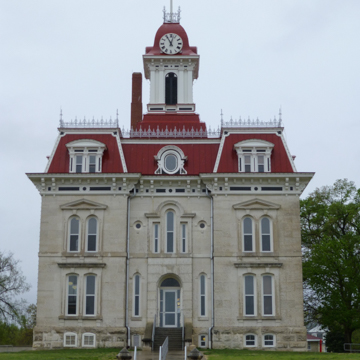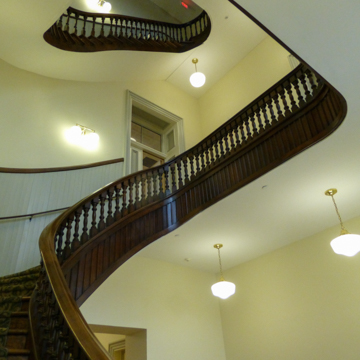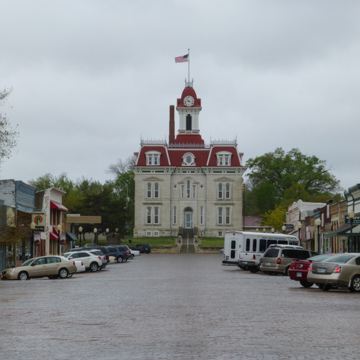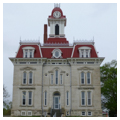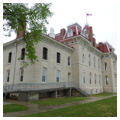The Chase County Courthouse is the oldest functioning courthouse in the state. It is a handsome and well-preserved example of the work of John G. Haskell, one of Kansas’s most highly regarded early architects.
In 1871, the 600 residents of Chase County passed a bond issue to fund the construction of a courthouse, and a prominent citizen donated a key parcel of land at the southern terminus of the town of Cottonwood Falls’s main street, which slopes up from the bridge crossing the Cottonwood River. Bids were taken for the construction of the building even before the building had been designed. The low bidder, John Bannon of Leavenworth, enlisted the services of Haskell to design the building and supervise its construction.
The building Haskell imagined was well suited to its prominent site. The slender, three-story limestone mass is capped by a red metal mansard roof and is highlighted by a central bell tower, with a six-foot-diameter clock. The courthouse provided the small community with a dominant, enduring, and iconic landmark. Cottonwood Falls would grow slowly, because the railroad elected to run its track through Strong City, a neighboring town on the opposite side of the river, instead of the established county seat.
The courthouse gave the primarily rural county a building that would serve it well through the years: the raised basement provides room for storage and mechanical equipment; the first floor accommodates county offices; the second floor contains a large, well-appointed courtroom and related chambers; and the third floor provides jury facilities. A two-story rear wing houses a jail. The most striking interior features are the stairs, which are made of black walnut and are cantilevered from adjacent walls. The main stair circles up three stories through the entry lobby under the tower, and a second, smaller but similarly constructed stair located between the building’s main volume and rear wing, serves the basement and the two main levels above.
Built with locally quarried limestone, the courthouse took two years to complete. During this time Haskell was busy with a variety of prestigious projects, including courthouses for Greenwood County, which was almost identical to the Chase County Courthouse, and for Barton County, which began a year after the other two buildings. He was also supervising the construction of the east wing of the State Capitol.
Haskell’s rise to prominence was similar in many ways to other early Kansas architects. Like most he was not native to the state, having been born in Vermont in 1832. After leaving home at the age of eleven, he took courses in science and mathematics, worked as a carpenter, and eventually found employment with Boston architectural firms. Meanwhile, in 1853, his family was recruited by the Emigrant Aid Company to move to Kansas to swell the ranks of the anti-slavery contingency, and thereby increase the chances that the territory would be admitted to the United States of America as a free state. When his father died in 1857, Haskell moved to Kansas to help take care of his mother and his younger siblings and established a fledgling architectural firm. After serving as a quartermaster in the Union Army during the Civil War, Haskell’s firm grew along with the proliferating communities of settlers who were entering the state. Like most architects of the time, Haskell was conversant with a variety of styles, but he seemed particularly comfortable with the Second Empire approach, and the Chase County Courthouse is representative of his best work.
References
Hall, Charles L., and Richard Pancratz, “Chase County Courthouse,” Chase County, Kansas. National Register of Historic Places Inventory–Nomination Form, 1970. National Park Service, U.S. Department of the Interior, Washington, D.C.
Peterson, John M. John G. Haskell: Pioneer Architect. Topeka, KS: Douglas County Historical Society, 1984.








